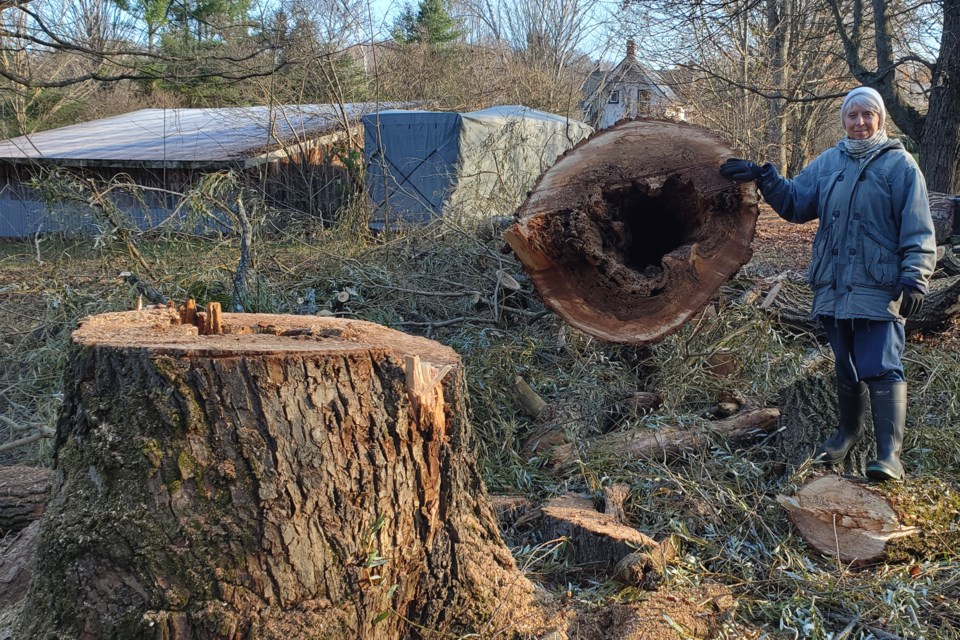As mentioned in an earlier article, we had a large willow tree snap in half during a recent ice storm. The demise of this tree led to a call for an arborist to come and dismantle two other ‘siblings’. While disappointing to have to cut them down, it was a relief to have these threats removed from beside our buildings.
These were weeping willows, with long descending branches of a distinct yellow hue. This particular species is often used as a landscape tree, as the unique shape provides a somewhat romantic aura with its curtain-like enclosure of hanging branches. Around 1960 my dad planted one in our backyard in Orillia, adding a nice centrepiece to an otherwise open double lot.
These three on our farm were planted by Julie’s dad around 45 years ago, done so by simply sticking cut branches in the mud of our ankle-deep creek. Three of the five sticks grew roots and transformed into glorious shade trees.
The big one we cut down was viewed with some sorrow by our elder daughter who, 30 years ago, played out her Disney-inspired fantasies seeking Grandmother Willow’s advice behind the veil of hanging yellow branches. But the tree was also younger back then and much smaller than the massive beast it became that we had to deal with today.
Big willows are fairly common around the shores of Lake Simcoe and Lake Couchiching, at least they are if you can find any natural shoreline still remaining. Most postcards from yesteryear have a background of willows leaning over romantic canoeists and young couples in rowboats.
Those big willows are not of the weeping variety, but rather are called crack willow. Crack willows lined the shore of Couchiching Beach Park in Orillia and were the first ‘climbing apparatus’ for youngsters visiting the area. Unfortunately, this species also has a tendency of growing too big for its own good and had to be removed for visitor safety.
Simcoe County is home for dozens of willow species and just as many hybrid varieties. Most prefer a damp to wet substrate in which to grow, but all crave sunshine and seldom survive in a shaded site. Their root’s lust for water worked against them in residential settings, as the roots sought out underground septic and water lines, often causing very expensive repairs for the homeowner.
Trying to identify one willow species from another is a good challenge for budding botanists ... as the saying goes, “they all look the same except they’re not.” A keen eye, an excellent identification book, and a heap of patience will see you through to the correct identification of most species.
The willow species that is probably well known to even the casual passer-by is pussy willow, that harbinger of spring with its fuzzy buds the shape and texture of a cat’s toe.
This one rarely gets beyond shrub size, as is the characteristic with most of our local willows. Other than the aforementioned weeping and crack willows and maybe also black and white willows (that’s two species, black willow and white willow ... if there was one called black-and-white willow I’d have written it that way) all the others are usually only head-high when mature.
They do have cool names: peach-leaved, sandbar, Bebb’s (also called beaked, just so you know), shining, basket, sage-leaved, heart-leaved, blue-leaved, bog and slender, to name a few. With such descriptive names one might think that identifying them would be a breeze ... not!
Young willow stems can be used for basketry as they are quite pliable and lend themselves to being woven and twisted into useful and unique baskets and decorations. Some species have a definite colour to their stem, thus making them desirable for inclusion in a willow branch creation.
No need to worry about over-harvesting these wispy stems as the roots will quickly send up replacement growth, thus a single plant can provide a weaving supply for many years in a row.
Willow bark contains the same pain relieving element as today’s commercial Aspirin, a trait learned early on by the First Peoples and shared with the later arriving colonists. The bark is bitter tasting, but then all good medicine is like that.
In Ireland willow sticks are punched into the damp soil and then woven together as a fence. As the sticks take root and grow, the tightly bound stems graft into each other and in a few years an impenetrable living willow fence will keep your sheep in the field they are supposed to be in.
While we will miss the sound of the wind in our willows, a new crop is no doubt planning a comeback, judging by the amount of sticks left lying on the ground. Will have to keep an eye on that.
